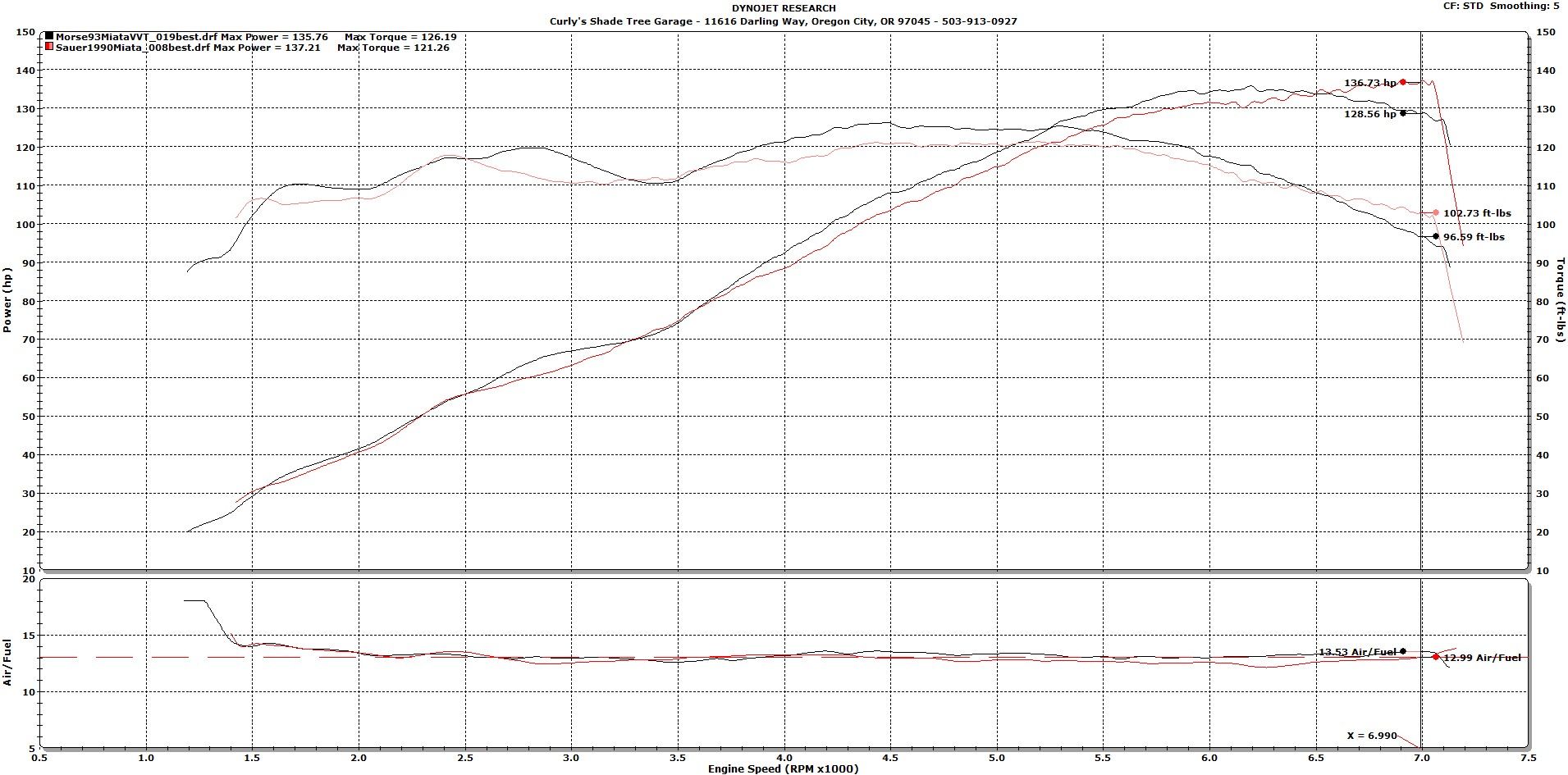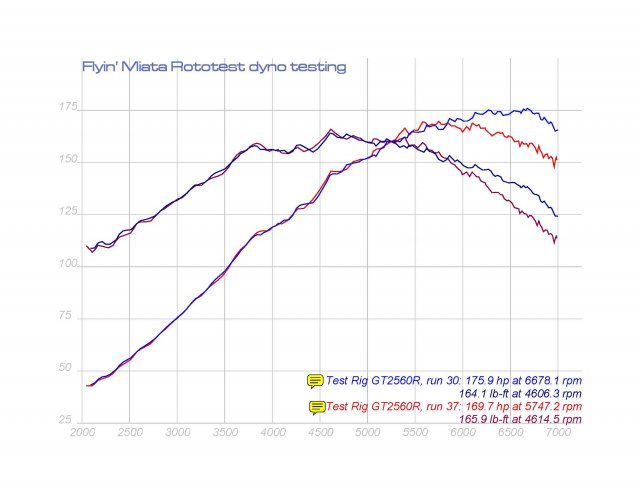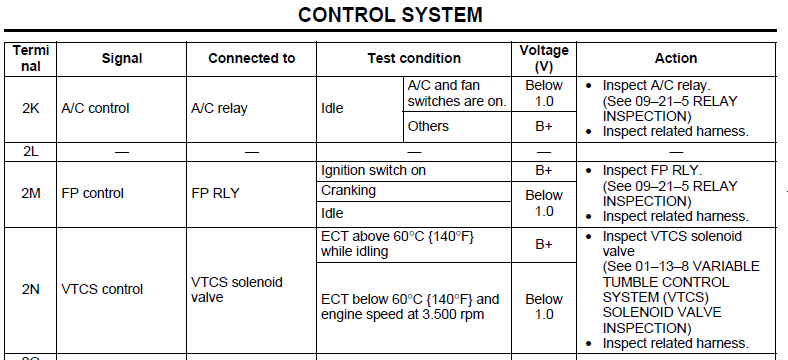VTCS manifold unpleasantness
#1
Despite all the experimenting we have done around here, we have never tried to make power with a VTCS manifold. I can now say with confidence that the swapping the VTCS for a VICS manifold needs to be put higher on the list of must do mods for any NB engine project.
Intuitively, this comes as no surprise. It's just that I had never given it any thought until this afternoon's dyno sessions.
We have an NB2 we recently rebuilt the engine in. 100% stock airflow and config, just forged rods and double valve springs.
Added an MS3 Pro ECU which gave us about 5whp on on otherwise bone stock engine, 124whp
Then we added an RB header mated to the stock cat/exhaust. This netted us about 8lbs tq through the midrange but no gain on top. This was a surprise as the header usually finds a little at higher rpm too.
We then added an RB header back exhaust (no cat). This found us about 4whp but only past about 6400rpm. Below that, not much. Now, scratchging our heads and second guessing base timing, compression, etc.
We then bolted on a K&N CARB legal intake kit, set up speed-density (no MAF). This found us just a few hp at the very top. WTF? We were at 128whp on CA91 where we expected to be about 138whp for an NB2 with I/H/E +ECU on CA91 and about 145whp on E85. So down about 10whp from where we expected to be. For reference, that's a brand new NB2 with I/H/E and ECU making 128whp. I've seen junkyard NB1's with stock NA6 ECU, big exhaust, stock NA8 header and CAI (with AFM) make about the same. The MS3 PnP ECU we're using does not have a connection to the VTCS by default so they're open all the time. I didn't post the dynos because we had the same problems getting a steady tach signal of the stock ignition. Plots are full of spikes and missing sections. Overlay 5 plots and it's gibberish.
What was most telling was how the three different hardware upgrades that typically add 5-7whp each added only 2-4whp each. This points to a significant restriction that obviates any work done elsewhere. Like having a Spec Miata restrictor in there.
The VTCS manifold butterflies are the culprit. Stick the equivalent of a 6mm allen key with a silver dollar stuck to it in each runner and see what it does for your power. Without direct A/B tests between the VTCS and VICS on the same engine, I'm would guess there is something like 7-9whp between them.
So yeah, if you have a VTCS manifold, either remove the butterflies and weld the holes shut or swap for a VICS. Now.
VICS and VTCS have the exact same runner and plenum dimensions.
While the square top will make the most power past 5000rpm, they're hard to find for less than $400 while the VICS can be found for $75 to a skilled googler.
VICS (Variable Inertia Charging System) 99-00 NB1
This manifold changes the resonant volume of the plenum by opening and closing a shutter to a separate chamber next to the main plenum. A small amount of air passes through the bleed passage, just to equalize pressures I think.
VTCS (Variable Tumble Control System) 01-05
This abomination has a set of butterflies in the runners right at the flange. When closed, they force the intake charge to tumble through a small slot at the top of the butterflies. Problem is those same butterflies pose a significant obstruction to flow even when they are wide open as they in a critical point in the intake system.
Did I just make the price of used VICS manifolds go up?
Intuitively, this comes as no surprise. It's just that I had never given it any thought until this afternoon's dyno sessions.
We have an NB2 we recently rebuilt the engine in. 100% stock airflow and config, just forged rods and double valve springs.
Added an MS3 Pro ECU which gave us about 5whp on on otherwise bone stock engine, 124whp
Then we added an RB header mated to the stock cat/exhaust. This netted us about 8lbs tq through the midrange but no gain on top. This was a surprise as the header usually finds a little at higher rpm too.
We then added an RB header back exhaust (no cat). This found us about 4whp but only past about 6400rpm. Below that, not much. Now, scratchging our heads and second guessing base timing, compression, etc.
We then bolted on a K&N CARB legal intake kit, set up speed-density (no MAF). This found us just a few hp at the very top. WTF? We were at 128whp on CA91 where we expected to be about 138whp for an NB2 with I/H/E +ECU on CA91 and about 145whp on E85. So down about 10whp from where we expected to be. For reference, that's a brand new NB2 with I/H/E and ECU making 128whp. I've seen junkyard NB1's with stock NA6 ECU, big exhaust, stock NA8 header and CAI (with AFM) make about the same. The MS3 PnP ECU we're using does not have a connection to the VTCS by default so they're open all the time. I didn't post the dynos because we had the same problems getting a steady tach signal of the stock ignition. Plots are full of spikes and missing sections. Overlay 5 plots and it's gibberish.
What was most telling was how the three different hardware upgrades that typically add 5-7whp each added only 2-4whp each. This points to a significant restriction that obviates any work done elsewhere. Like having a Spec Miata restrictor in there.
The VTCS manifold butterflies are the culprit. Stick the equivalent of a 6mm allen key with a silver dollar stuck to it in each runner and see what it does for your power. Without direct A/B tests between the VTCS and VICS on the same engine, I'm would guess there is something like 7-9whp between them.
So yeah, if you have a VTCS manifold, either remove the butterflies and weld the holes shut or swap for a VICS. Now.
VICS and VTCS have the exact same runner and plenum dimensions.
While the square top will make the most power past 5000rpm, they're hard to find for less than $400 while the VICS can be found for $75 to a skilled googler.
VICS (Variable Inertia Charging System) 99-00 NB1
This manifold changes the resonant volume of the plenum by opening and closing a shutter to a separate chamber next to the main plenum. A small amount of air passes through the bleed passage, just to equalize pressures I think.
VTCS (Variable Tumble Control System) 01-05
This abomination has a set of butterflies in the runners right at the flange. When closed, they force the intake charge to tumble through a small slot at the top of the butterflies. Problem is those same butterflies pose a significant obstruction to flow even when they are wide open as they in a critical point in the intake system.
Did I just make the price of used VICS manifolds go up?

__________________
#5
Variable tumble systems have never been for peak power. Tumble and flow capability are two competing aspects in head design, whether you have a fixed tumble port (just a restrictive edge to induce tumble motion) or a variable tumble system with a valve.
Variable runner length and plenum volume systems are for changing the torque curve through pulsation effects, especially in n/a applications. They go by different names. Mazda has different ones.
Notice how the variable tumble system came in 2001? That's to help meet emission standards that were tightening. Variable tumble also works with variable valve timing, as higher tumble tolerates the internal egr from overlap.
It's just a different set of priorities for the 2001 combustion system.
Variable runner length and plenum volume systems are for changing the torque curve through pulsation effects, especially in n/a applications. They go by different names. Mazda has different ones.
Notice how the variable tumble system came in 2001? That's to help meet emission standards that were tightening. Variable tumble also works with variable valve timing, as higher tumble tolerates the internal egr from overlap.
It's just a different set of priorities for the 2001 combustion system.
#8
I've never seen any data showing when the variable tumble system runs on stock ecu. It's probably only closed during part load with intake cam advance. It could also close for cold start emissions.
Does anyone know? Is it active at all in say a dyno pull on a stock car?
Does anyone know? Is it active at all in say a dyno pull on a stock car?
#10
Seriously, I have 2 I'd love to get rid of. Was hoping for $75 + shipping, but I guess I'll have to settle for scrap value.
#13
The VICS and VTCS are the same shape so power should be about the same once the VTCS butterflies are removed.
None of this is news. It was widely published and most anyone that spends time tuning Miatas knows the VTCS was for emissions, at the direct expense of power. The primary reason the NB2 power claim fiasco when the NB2 was launched. I though the BP6D cams had a lot to do with it but they only lose about 4-5whp at peak over the BP4W cams but produce at least that much more midrange torque so that's a fair tradeoff. What surprised me is just how much the VTCS mech cost. Realistically, it's 10whp. Crikey
Variable tumble systems have never been for peak power. Tumble and flow capability are two competing aspects in head design, whether you have a fixed tumble port (just a restrictive edge to induce tumble motion) or a variable tumble system with a valve.
Variable runner length and plenum volume systems are for changing the torque curve through pulsation effects, especially in n/a applications. They go by different names. Mazda has different ones.
Notice how the variable tumble system came in 2001? That's to help meet emission standards that were tightening. Variable tumble also works with variable valve timing, as higher tumble tolerates the internal egr from overlap.
It's just a different set of priorities for the 2001 combustion system.
Variable runner length and plenum volume systems are for changing the torque curve through pulsation effects, especially in n/a applications. They go by different names. Mazda has different ones.
Notice how the variable tumble system came in 2001? That's to help meet emission standards that were tightening. Variable tumble also works with variable valve timing, as higher tumble tolerates the internal egr from overlap.
It's just a different set of priorities for the 2001 combustion system.
__________________
#14
Morse: VTCS with butterflys removed, junk yard VVT, stock NB2 header, MSpro, exhaust shop special from header back, ~10" intake to headlight area.
Sauer: VICS, rebuilt VVT with shaved head, Ebay RB copy, Rev MS3, enthuza test pipe, RB mid pipe and muffler, K&N intake.
The junk yard motor sadly made more power, I really need to get back to the dyno with the Sauer engine and see if some VVT tuning will result in similar gains down low. But Morse has 4 extra hp/ftlbs from 4k to 6250, then by 7000rpm, Sauer suddenly has 9 extra hp and 6 more ft/lbs.
I've always attributed this to his VICS manifold, no?

#15
Joined: Jun 2005
Posts: 19,338
Total Cats: 574
From: Fake Virginia
VTCS never closes when the car is warm. It is for cold idle only.
Here is the control specification for the VTCS solenoid straight out of the FSM:
In other words, not ever intended as performance mod. Not even in concert with VVT (not sure where that came from).
Here is the control specification for the VTCS solenoid straight out of the FSM:
ECT below 60°C {140°F}
while idling :ON
while idling :ON
#16
That's consistent with this graph from the FM test on a low-boost turbo car. VTCS peaks around 6k where the VICS keeps climbing.
From this thread:
FM turbo testing, intake manifold shootout! - MX-5 Miata Forum
Functioning VICS vs. de-butterflied VTCS.

From this thread:
FM turbo testing, intake manifold shootout! - MX-5 Miata Forum
Functioning VICS vs. de-butterflied VTCS.

#17
I'd argue this.
Morse: VTCS with butterflys removed, junk yard VVT, stock NB2 header, MSpro, exhaust shop special from header back, ~10" intake to headlight area.
Sauer: VICS, rebuilt VVT with shaved head, Ebay RB copy, Rev MS3, enthuza test pipe, RB mid pipe and muffler, K&N intake.
The junk yard motor sadly made more power, I really need to get back to the dyno with the Sauer engine and see if some VVT tuning will result in similar gains down low. But Morse has 4 extra hp/ftlbs from 4k to 6250, then by 7000rpm, Sauer suddenly has 9 extra hp and 6 more ft/lbs.
I've always attributed this to his VICS manifold, no?
Morse: VTCS with butterflys removed, junk yard VVT, stock NB2 header, MSpro, exhaust shop special from header back, ~10" intake to headlight area.
Sauer: VICS, rebuilt VVT with shaved head, Ebay RB copy, Rev MS3, enthuza test pipe, RB mid pipe and muffler, K&N intake.
The junk yard motor sadly made more power, I really need to get back to the dyno with the Sauer engine and see if some VVT tuning will result in similar gains down low. But Morse has 4 extra hp/ftlbs from 4k to 6250, then by 7000rpm, Sauer suddenly has 9 extra hp and 6 more ft/lbs.
I've always attributed this to his VICS manifold, no?
While I'm mildy curious to see if a de-VTCS'd NB2 manifold makes the same power as a VICS manifold, we alreedy know the VICS actuation has a small but positive effect on powerband shape and peak power. So in my view, one still wants the VICS, all else being equal. Most torque we have ever made with stock NB2 cams was with a VICS manifold with two switching points in the VICS table.
__________________
#19
Joined: Sep 2005
Posts: 33,556
Total Cats: 6,933
From: Chicago. (The less-murder part.)
From the '02 FSM:

In this case, B+ means that the valve is not active (we're seeing battery voltage pulling up the pin through the solenoid), so it looks like they're always open above 140°F.
I'd also be extremely curious to see how the VICS and VTCS manifolds compare at low to mid RPM with a stock ECU and no I/H/E modifications.

















